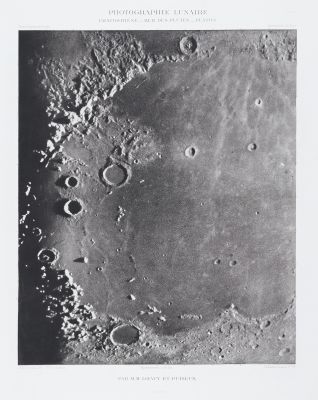
Title
Pl. XX: Maurolycus, Werner, SacroboscoArtists
Loewy, Maurice (French, 1833-1907)Piuseux, Pierre Henri (French, 1855-1928)Publication
Atlas Photographique de la LuneDate
1894Process
PhotogravureAtelier
Fillon et HeuseImage Size
57.7 x 47.4 cmSheet Size
75.5 x 57.5 cm.
The ultimate achievement of nineteenth-century astronomical photography.
Moritz Loewy and Pierre-Henri Puiseux, assisted by Charles Morvan, undertook a project to make a complete series of detailed photographs of the moon and the lunar surface. Their work, which took nearly 14 years, is considered the finest and most meticulous of the moon until the 1960s space probes. Between 1894 and 1909, the two astronomers devoted approximately 500 evenings to observations to make more than 6,000 photographs of the moon. Their very best images were then published between 1896 and 1910 in L’Atlas photographique de la Lune. The atlas includes 82 beautiful photogravure plates (11 smaller contact plates and 71 enlargements). The majority of the photographic reproductions by heliogravure were entrusted to M. Fillon at Heuse, Gaultier and Schutzenberger.
Earlier attempts at photographing the moon had suffered from difficulties with the sensitivity of collodion emulsions and with atmospheric ‘blurring’. Optimal conditions were a calm atmosphere and little to no change in temperance, factors which did not combine often. In the first year, out of 50 or 60 evenings spent making photographs of the moon, just 4 or 5 nights gave the faultless results they needed. With the shutter required to open at times for more than 3 seconds, they needed a special lens which when used in conjunction with equatorial and refracting telescopes, moved to exactly compensate for the earth’s rotation – preventing any blurring during the necessarily long exposure times.
Loewy did not live to see the project completed; he died in 1907, after which Charles le Morvan assisted Puiseux. Ann Thomas describes this work in Beauty of Another Order: Photography in Science: ‘The scientific and aesthetic tour de force of lunar photography was the translation by Pierre Puiseux (1855 – 1928) and Charles le Morvan (1865 – 1933) of a number of photographic negatives of the moon into enormous, crisply detailed and visually stunning photogravures…it was unequaled as a photographic atlas until 1960, and the quality of the plates has perhaps never been surpassed. One interesting feature of the photographs is that a hand-operated shutter was used to give the brightest areas the least exposure on the negatives. The final prints were produced by the unusual sand photogravure technique’ [1]
References
[1] Thomas, Ann, Marta Braun, Mimi Cazort, Martin Kemp, John P. MacElhone, and Larry J. Schaaf. Beauty of Another Order. New Haven a. London: Yale University Press, 1997. p. 205
Quentin Bajac, Chief Curator of Photography, Museum of Modern Art, New York (from: Atlas-9781907946851.epub)
William Ashworth, The Face of the Moon; exhibition catalogue, Linda Hall Library, 1989, no. 29
Frizel, ed., A New History of Photography, pp. 278-79
E.A. Whitaker, Mapping and naming the Moon
The Photobook: a History, Vol. I, p. 54





